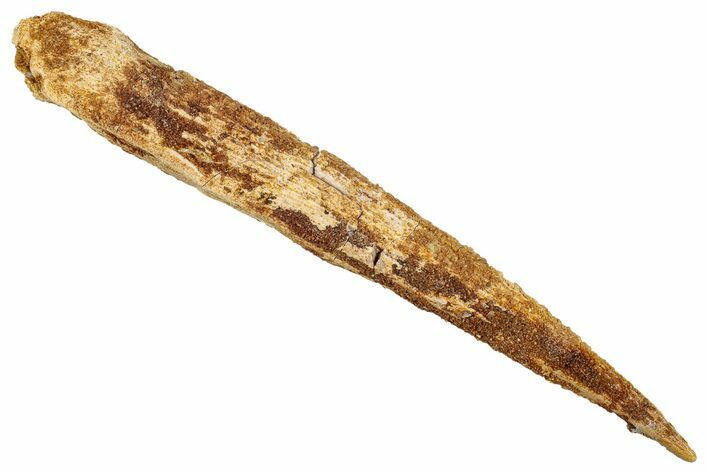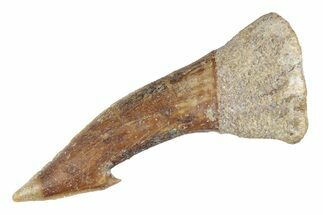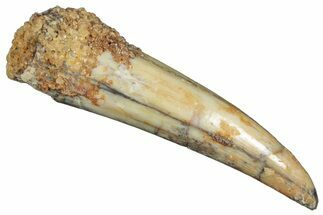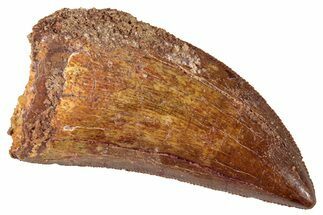5.6" Fossil Shark (Asteracanthus) Dorsal Spine - Kem Kem Beds
This is a 5.6" long fossil dorsal spine of a shark (Asteracanthus ornatissimus). It comes from the Late Cretaceous-aged Kem Kem Beds near Taouz, Morocco. There are two hybodontiform sharks whose spines are found in this formation with Asteracanthus being the rarer of the two.
It has glue stabilized cracks along its length as these spines are fairly delicate and typically are found fractured.
It has glue stabilized cracks along its length as these spines are fairly delicate and typically are found fractured.
Asteracanthus ornatissimus is an extinct species of hybodontiform, a cartilaginous fish closely related to modern sharks and rays. It lived from the Middle Jurassic to the Early Cretaceous (about 165 to 100 million years ago) in the seas of what is now west-central Europe. Like other hybodonts, Asteracanthus possessed distinct sets of teeth and fin spines, which are often the only preserved parts of these animals. A rare complete A. ornatissimus specimen was quarried from the Solfhonen Limestone of Bavaria, Germany in 2021, giving vital insight into this species' morphology.
A. ornatissimus's teeth were specialized for grasping and crushing all kinds of small shelled and soft-bodied prey, which it likely scavenged for while browsing seafloors of the open ocean. Its extinction may have been caused by eventual supplanting by modern sharks.
Hybodonts were a group of shark-like cartilaginous fish that existed from the Devonian all the way to the Cretaeous-Paleogene extinction event. They are characterized by distinct fin spines and mouths of flattish teeth specialized for crushing, tearing, and grinding. Fossil evidence indicates they were adapted to all kinds of freshwater, estuarine, and marine environments. Modern sharks eventually overtook their ecological niches in marine environments.
A. ornatissimus's teeth were specialized for grasping and crushing all kinds of small shelled and soft-bodied prey, which it likely scavenged for while browsing seafloors of the open ocean. Its extinction may have been caused by eventual supplanting by modern sharks.
Hybodonts were a group of shark-like cartilaginous fish that existed from the Devonian all the way to the Cretaeous-Paleogene extinction event. They are characterized by distinct fin spines and mouths of flattish teeth specialized for crushing, tearing, and grinding. Fossil evidence indicates they were adapted to all kinds of freshwater, estuarine, and marine environments. Modern sharks eventually overtook their ecological niches in marine environments.
The Kem Kem Group is famous for yielding a diverse Late Cretaceous vertebrate assemblage, including fish, reptiles, and dinosaurs such as Spinosaurus. These fossils are found in a thin bed that outcrops around the edge of a large plateau near Taouz, Morocco. Local miners collect these fossils by digging narrow tunnels by hand into this plateau, following the layer.
A paper on this assemblage can be found at: Vertebrate assemblages from the early Late Cretaceous of southeastern Morocco: An overview
A paper on this assemblage can be found at: Vertebrate assemblages from the early Late Cretaceous of southeastern Morocco: An overview
SPECIES
Asteracanthus ornatissimus
LOCATION
Taouz, Kem Kem Basin, Morocco
FORMATION
Kem Kem Beds
SIZE
5.6" long
CATEGORY
ITEM
#277667
We guarantee the authenticity of all of our
specimens. Read more about our
Authenticity Guarantee.
specimens. Read more about our
Authenticity Guarantee.
 Reviews
Reviews












